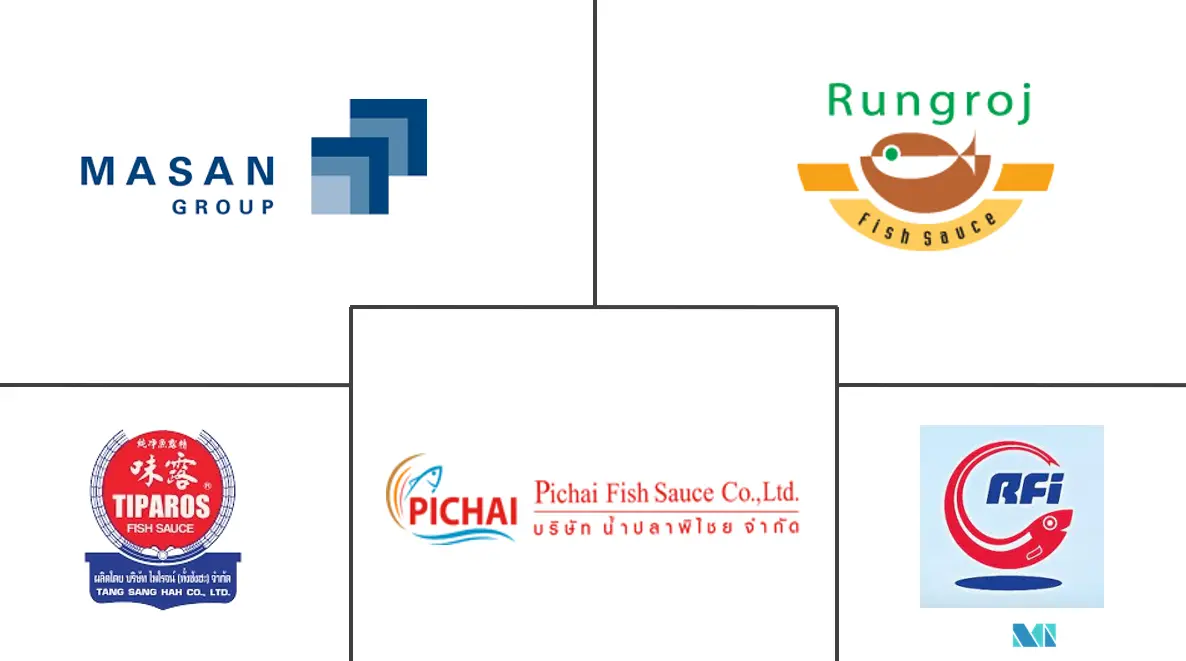Market Size of Asia-Pacific Fish Sause Industry

| Study Period | 2019 - 2029 |
| Base Year For Estimation | 2023 |
| Market Size (2024) | USD 6.23 Billion |
| Market Size (2029) | USD 8.44 Billion |
| CAGR (2024 - 2029) | 6.28 % |
| Market Concentration | Low |
Major Players
*Disclaimer: Major Players sorted in no particular order |
Asia Pacific Fish Sauce Market Analysis
The Asia-Pacific Fish Sause Market size is estimated at USD 6.23 billion in 2024, and is expected to reach USD 8.44 billion by 2029, growing at a CAGR of 6.28% during the forecast period (2024-2029).
- Traditional influences are a significant factor in the popularity of sauces, dressings, and condiments in the Asia-Pacific region. Local consumers tend to prefer familiar products with flavors they know and enjoy, and traditional preparations often provide that familiarity. As a result, many sauces, dressings, and condiments in the region are made using traditional methods and ingredients, which contributes to their popularity among local consumers. Fish sauce is particularly popular in China, Southern Asia, and South East Asian countries, with Vietnamese consumers valuing traditionally made fish sauces for their perceived health benefits due to higher nitrogen content.
- The market for fish sauce is driven by the availability of different varieties, including gluten-free fish sauce, which is popular in Thai and Vietnamese cuisine. This product is widely available in supermarkets and grocery stores throughout the region, with manufacturers offering various packaging sizes to cater to customer needs. For example, Chang's offers a 150ml size of gluten-free fish sauce in Australia.
- Consumers in the region not only use fish sauce as a seasoning ingredient in cooking but also as a dipping sauce, which is expected to drive demand for the product. However, the availability of substitutes, concerns about added preservatives, and increasing interest in vegan foods may limit the growth of the fish sauce market.
Asia Pacific Fish Sauce Industry Segmentation
Fish sauce is a condiment that is commonly used in Southeast Asian cuisine. It is made from fermented fish, usually anchovies or other small fish, that are mixed with salt and left to ferment for several months to a year.
The Asia-Pacific fish sauce market is segmented by product type, composition, end user, and country. Based on product type, the market is segmented into industrial and traditional. Based on composition, the market is bifurcated into basic and premium. The end-user segment is divided into food manufacturers, retail, and food service. Furthermore, the market is segmented by country into China, Japan, India, Vietnam, Thailand, Indonesia, and the Rest of Asia-Pacific.
For each segment, the market sizing and forecasts have been done based on value (in USD million).
| Product Type | |
| Industrial | |
| Traditional |
| Composition | |
| Basic | |
| Premium |
| End-User | |
| Food Manufacturers | |
| Retail | |
| Food Service |
| Country | |
| China | |
| Japan | |
| India | |
| Vietnam | |
| Thailand | |
| Indonesia | |
| Rest of Asia-Pacific |
Asia-Pacific Fish Sause Market Size Summary
The Asia-Pacific fish sauce market is experiencing significant growth, driven by traditional culinary practices and the increasing popularity of Southeast Asian cuisine. Fish sauce is a staple condiment in countries like Vietnam, Thailand, and Cambodia, where it is used as a seasoning and flavor enhancer. The market is characterized by a diverse range of products, including gluten-free options, which cater to the preferences of local consumers. The demand for fish sauce is further bolstered by its use in both cooking and as a dipping sauce, although concerns about preservatives and the rise of vegan alternatives pose potential challenges to market expansion. The fortification of fish sauce with micronutrients, such as iron, is also gaining traction as a public health initiative in several Asian countries, enhancing its appeal and market potential.
The competitive landscape of the Asia-Pacific fish sauce market is dominated by a few key players, such as Masan Group and Pichai Fish Sauce Co., Ltd., who leverage brand recognition and strategic expansion to maintain their market positions. These companies focus on innovative packaging and clean label claims to attract health-conscious consumers. Recent product launches and promotional strategies, like those by Hoang Gia Fish Sauce, highlight the dynamic nature of the market, as companies strive to meet diverse consumer needs and preferences. The growing demand for premium and fortified fish sauces, particularly in Vietnam, underscores the market's potential for continued growth and development in the coming years.
Asia-Pacific Fish Sause Market Size - Table of Contents
-
1. MARKET DYNAMICS
-
1.1 Market Drivers
-
1.2 Market Restraints
-
1.3 Porter's Five Forces Analysis
-
1.3.1 Threat of New Entrants
-
1.3.2 Bargaining Power of Buyers/Consumers
-
1.3.3 Bargaining Power of Suppliers
-
1.3.4 Threat of Substitute Products
-
1.3.5 Intensity of Competitive Rivalry
-
-
-
2. MARKET SEGMENTATION
-
2.1 Product Type
-
2.1.1 Industrial
-
2.1.2 Traditional
-
-
2.2 Composition
-
2.2.1 Basic
-
2.2.2 Premium
-
-
2.3 End-User
-
2.3.1 Food Manufacturers
-
2.3.2 Retail
-
2.3.3 Food Service
-
-
2.4 Country
-
2.4.1 China
-
2.4.2 Japan
-
2.4.3 India
-
2.4.4 Vietnam
-
2.4.5 Thailand
-
2.4.6 Indonesia
-
2.4.7 Rest of Asia-Pacific
-
-
Asia-Pacific Fish Sause Market Size FAQs
How big is the Asia-Pacific Fish Sause Market?
The Asia-Pacific Fish Sause Market size is expected to reach USD 6.23 billion in 2024 and grow at a CAGR of 6.28% to reach USD 8.44 billion by 2029.
What is the current Asia-Pacific Fish Sause Market size?
In 2024, the Asia-Pacific Fish Sause Market size is expected to reach USD 6.23 billion.

